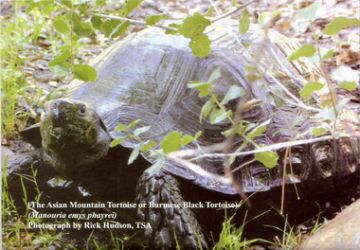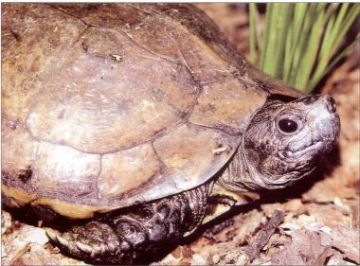When I bade farewell to my readers in October and I introduced Anne Rowberry as my successor, I did not think I would be sitting down again so soon to make an appeal for funds from you on behalf of the endangered species of Asian turtles. However while I was away on a short holiday there came an urgent request from Rick Hudson, co-founder of the Turtle Survival Alliance for help from the BCG to assist in the rescue of the Asian Mountain Tortoise (Manouria emys phayrei), the Arakan Forest Turtle (Heosemys depressa) and the Red Crowned Roof Turtle (Batagur kachuga or Kachuga kachuga). I have known Rick for about 9 years and have worked with him before on the conversion of the ex-crocodile ponds in Madras and the construction of the captive breeding facilities at Mandalay Zoo for the extremely rare Kachuga trivittata species - both of which were splendidly supported by you and are a great success. I know that if Rick asks for our help it arises from a genuine need and demands my effort. So, with Anne's agreement, I come to you once again with a Conservation Appeal.
ASIAN TURTLE CRISIS
It was in the Conservation Appeal of 2001 that I first drew members' attention to the catastrophe that was unfolding throughout Asia (mainly SE Asia) with the rapid depletion of the numbers of tortoises and terrapins there. If you turn back to that Appeal (Issue No 138 Nov/Dec 2000) you will see in detail the reasons - local consumption for food and the trade to China for the same reason, the destruction of their habitat, collection for the pet trade, the use of their body parts for Chinese medicine and the pollution of the streams and rivers. I likened the collection of these practically defenceless (against humans) reptiles to the action of a huge vacuum cleaner sucking them out and sending them in appalling conditions to Hong Kong, China, Taiwan, Japan etc. The trade was so enormous that whole species were being threatened with extinction.
COLONIES OF ASSURANCE
One of the remedies of conservationists such as Rick Hudson was to set up the Turtle Survival Alliance and with funds raised to establish Colonies of Assurance. In suitable holding areas and with appropriate captive breeding facilities, preferably in their native habitat, collections of rare turtles would be gathered together in the principle of the Ark. And so the BCG has helped over the years in this work and we can look back with pride on such success stories as the Vietnamese Flowerbacks (Cuora galbinifrons) at Jersey Zoo and the Kachuga trivittata at Mandalay Zoo in Burma. But the tragedy is continuing and if the trade has diminished over the past two or three years, it is only because turtles are becoming so rare that it is difficult to find them. Of course the rarer they become the greater is the monetary value of those that remain and this in turn stimulates the hunting!
THE THREE SPECIES
Now let me deal with the species for which our financial aid is being asked:
Batagur kachuga or Kachuga kachuga - the Red Crowned Roof Turtle. This species was once quite numerous throughout N India, Nepal and Bangladesh but sadly because of India's long history of traditional consumption of this turtle it is now threatened with extinction. The Madras Crocodile Bank Trust in cooperation with the Turtle Survival Alliance have initiated the conservation of this river turtle and is now breeding more than 1000 hatchlings a year in the National River Chambal Sanctuary in India. These are normally released as hatchlings when they are most vulnerable to predators both avian and fish. So now the plan is to hold back about 100 a year for 3 years when they will reach a size and weight (1000 grammes) so as to afford them greater chance of survival. To do this the MCBT need to renovate the defunct Deori Gharial (Crocodile) Center and create new facilities for holding at the Garhaita Turtle Rehabilitation Centre. 'Green' conservation methods will be employed filtration will be biologically maintained and the pumping system will be solar/wind driven. The total cost will be $US7500 and the TSA will advance $2500. The BCG is asked to contribute $5000 and be the major partner in the enterprise for which we will be given full credit.
Manouria emys phayrei - the Burmese Black Tortoise aka Asian Mountain Tortoise. The habitat of this muchendangered reptile is in the evergreen forests at moderate elevation of Thailand, Burma, Assam and Bangladesh. Habitat destruction and collection for food has decimated its numbers throughout the region. Hunting pressures are so intense that villagers use trained dogs to hunt them down. The TSA found 72 of this species at Mandalay Zoo in Burma together with some recently released species after confiscation - the latter were rescued and treated. These specimens represented an excellent opportunity to establish two colonies of assurance - one at Mandalay Zoo and the other at the Yoma Elephant Range sanctuary at Gwa in W Burma. The staff there are already looking after turtles and have the expertise to care for the Burmese Black Tortoises and the Arakan Forest Turtle.
Heosemys depressa - or Arakan Forest Turtle is a species, which is confined to a small area of Arakan, in S. Burma and is critically endangered. It was once thought to be extinct and not until specimens were found in the Chinese food markets in the mid 1990s was it virtually rediscovered. There are some captive specimens in the USA and a few in Burma but in the latter they lack the conditions for captive breeding which is urgent while living animals are still available.
The plans for the proper conservation holding and breeding for both the Burmese Black Tortoise and the Arakan Forest Turtle allow for about half to be housed in much better conditions in Mandalay Zoo where there will be four groups of nine. This will be paid for by the TSA. The BCG is being asked to finance the construction of completely new ponds at the Yoma Elephant Range sanctuary, which is most suitable because it is within the natural climatic area for the turtles - cool and moist. There are also staff trained in the care of chelonia there and it is hoped that captive breeding will be successful. The two new enclosures will cost $3000 for the Burmese Black Tortoises and $2000 for Arakan Forest Tortoise one.
SUMMARY
So once more I come to you with my begging bowl! The total cost of both the Indian and Burmese projects comes to US$ 10,000 or £4830 at the current rate of exchange. We have raised this before and more and I would like to think we can maintain this great record of success with our Appeals. Even though I have officially retired at 31 Dec 07 I will write again throughout 2008 telling you how the planning is coming to fruition and with more details, photos etc. If you like you can make a donation when you renew your membership by adding the amount you wish to donate to the form or you can send a separate donation by cheque. Please make the cheque out to the 'British Chelonia Group' specifying that you want the money to go to the 2008 Conservation Appeal and send this to the Membership Secretary BCG, PO Box 1460, Bedworth, CV12 9ZW And thank you on behalf of the Endangered Asian Turtles.
Nov 07. BOB LANGTON, CONSERVATION OFFICER (1989 - 2008).
Note. I am indebted to Rick Hudson of Fort Worth Zoo, USA, Shailendra Singh of MCBT, INDIA and Dr Brain Horne of the Zoological Society of San Diego for data contained in this Appeal.
The turtles in Mandalay Yadanabon Zoo survived the horrific cyclone and political upheaval. The breeding programme will go ahead but will probably be a little delayed. The Burma turtle team is in the US now for training this summer and once they return in September the project should go ahead. Rick Hudson will be running a workshop for the team in Mandalay when they return. I hope we can get back over there to do the workshop and then move several pieces forward that have been stalled due to the cyclone and political upheaval.
Thank you so much for your generosity, we have reached our target for this project £5000
Anne Rowberry - Conservation Officer
Top



